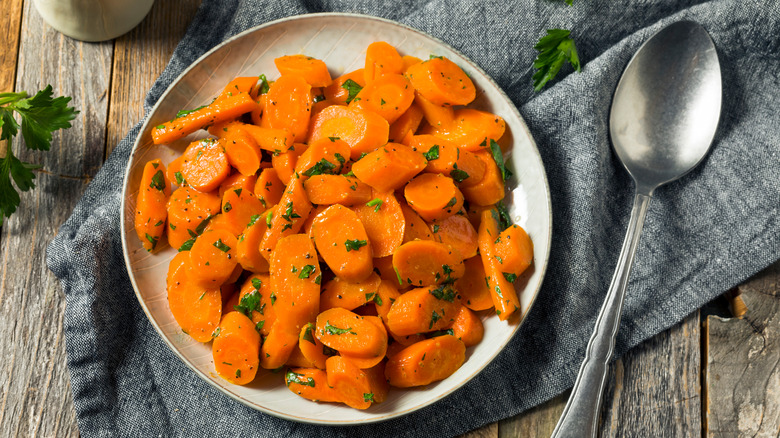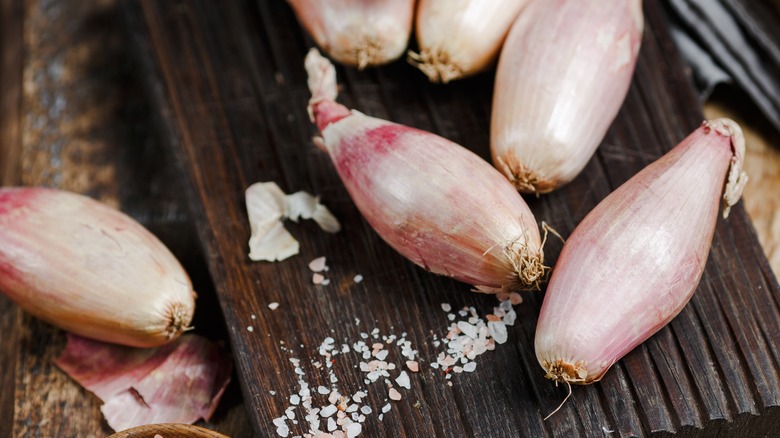Anthony Bourdain's Tip For Restaurant-Worthy Veggies At Home
We may receive a commission on purchases made from links.
When cooking at home, it's easy to focus predominantly on the main dish, and not pay so much attention to the sides, especially vegetable dishes such as plain old carrots. But when you eat in a good restaurant and see just how unbelievably delicious these underrated orange gems can actually taste, it's enough to make you vow to reconsider the approach. And Anthony Bourdain had an especially tasty method for elevating carrots: cooking them in a French fashion.
The late chef was full of tips to help home cooks recreate restaurant-quality dishes at home; Anthony Bourdain's advice for slicing onions helped us prep like a pro, and his carrot technique is just as rewarding. The dish, known as Vichy carrots, involves cooking the carrots in sugar and just a little water, creating a glossy glaze while enhancing the appearance, texture, and flavor of the vegetable.
Vichy carrots, or carottes à la Vichy, takes its name from a town in central France where the spring water is exceptionally high quality; indeed, to truly deserve the name, the vegetables should be cooked in Vichy Saint-Yorre mineral water according to French culinary encyclopedia "Larousse Gastronomique." Traditionally, the carrots are cooked in water, sugar, and baking soda (or Vichy salt) until all the liquid has been absorbed by the root vegetables before they're served, traditionally dotted with butter. But Bourdain's technique incorporates the butter — in vast amounts — into the cooking process itself. And the method can be applied to other vegetables, too.
Bourdain's Vichy carrots are glazed in butter and sugar
Anthony Bourdain once revealed that "butter is in everything" when professional chefs cook (via The New Yorker) and that diners could be consuming almost a full stick when eating in restaurants. And true to his word, he was not shy when it came to adding the rich dairy to his Vichy carrots. In fact, he added a whopping two pounds of the stuff — or in his own no-nonsense description, a "crapload" (per YouTube).
Bourdain's method involves putting evenly sliced carrots in a pan, adding water, butter, and a cup-and-a-half of sugar, and simmering over low heat until the carrots are tender and glazed. While Bourdain prepared his carrots cut on the bias to produce a larger surface area for the glaze, they can also be cut vertically for Vichy style, in halves or quarters. Or leave them whole; baby carrots look especially appealing for this method, and even more convenient as they don't need peeling or chopping.
The Vichy method produces delicious cabbage, too; simply add greens, water, and butter to a pan and cook for a few minutes with the lid on. Or try it with Brussels sprouts. Add the cut veg to a shallow pan with butter and four tablespoons of water. Cover with a lid, then cook for five minutes before adding sugar or honey, and perhaps a little miso for an umami punch; cook for another few minutes until soft with an attractive sheen.
More tips from Anthony Bourdain to prep veg like a pro
To get the best results when cooking vegetable dishes, you need to start with good ingredients. For Anthony Bourdain, that meant hunting for perfectly ripe produce that was in season. If you buy your veg at a market, try asking questions to develop confidence when picking out products.
When it comes to cooking veg, mise en place was key for the chef, especially when entertaining. It's a French cooking trick all home cooks should know, meaning all your vegetables and other ingredients are chopped and laid out in front of you before you start — to make the process easier and enjoyable. And when you've cooked a dish, take a tip from Bourdain and garnish it with fresh herbs such as parsley or chervil for extra flavor and a professional finish.
Bourdain was a particular fan of some vegetables above others, and one of these was shallots. Popular in classical French cookery, shallots are sweeter and milder than onions and tend to work as well raw as when cooked. For the late chef, shallots were an ingredient that could elevate home cooking to restaurant level, despite home cooks not using them as frequently as other alliums. The late chef used them in everything, from raw in salads to adding depth to a gravy. He also loved them with steak, either covering one side of a resting steak with the diced vegetable or using them in an accompanying sauce.



